Remembering
125 YEARS SINCE THE FOUNDATION OF THE NEW CEMETERY AND BELGRADE PUBLIC UTILITY COMPANY ”POGREBNE USLUGE”
A Place of Memory and Piety
It was founded in 1886, at the time of the rapid urban rearrangement of the town of Belgrade. Its founder, famous Vladan Djordjević, M.D., donated his estate for the construction. The history of this city and this country, their highest achievements and deepest dramas, can also be observed through the heritage of the New Cemetery. In 1983, it was officially proclaimed a cultural and historical good of extraordinary importance for Serbia
By: Zoran Marković
 Every époque of Belgrade, Serbia and Yugoslavia left an inerasable mark on the New Belgrade Cemetery – says director of the Public Utility Company ”Pogrebne usluge” (”Funeral Services”), Dragan Baltovski, M.A. – There, on the monuments, sculptures, reliefs, we can read the spirit of time, separate époques, reconstruct parts of our history. Therefore the New Cemetery is an open testimony of history. It is the first architecturally planned and designed cemetery, one of the important elements of Belgrade becoming a European metropolis. The Cemetery was founded in 1886, at the time of the rapid urban rearrangement of the town of Belgrade, marked by destroying hovels, cutting wide and straight streets, construction of the first modern multi-storey buildings (some of which we continue admiring even today). Every époque of Belgrade, Serbia and Yugoslavia left an inerasable mark on the New Belgrade Cemetery – says director of the Public Utility Company ”Pogrebne usluge” (”Funeral Services”), Dragan Baltovski, M.A. – There, on the monuments, sculptures, reliefs, we can read the spirit of time, separate époques, reconstruct parts of our history. Therefore the New Cemetery is an open testimony of history. It is the first architecturally planned and designed cemetery, one of the important elements of Belgrade becoming a European metropolis. The Cemetery was founded in 1886, at the time of the rapid urban rearrangement of the town of Belgrade, marked by destroying hovels, cutting wide and straight streets, construction of the first modern multi-storey buildings (some of which we continue admiring even today).
SMALL TIME-MACHINE
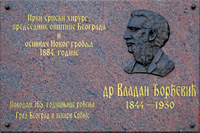 1883. Purchasing of pieces of land for the New Cemetery in Belgrade began. 32 hectares of land were bought. 1883. Purchasing of pieces of land for the New Cemetery in Belgrade began. 32 hectares of land were bought.
1884. The New Cemetery was entered into the urbanism plan of the city for the first time. Its founder, Vladan Djordjević, M.D. (then president of the Municipality of Belgrade, erudite, first educated surgeon, founder of Serbian military surgery, Serbian Medical Doctors’ Society, talented and productive writer, diplomat and statesman) donated his estate for the construction of the Cemetery.
1886. Funerals began at the New Cemetery on August 17.
1893. Construction of the Church of St. Nicholas in the central part of the Cemetery, in Serbian-Byzantine style.
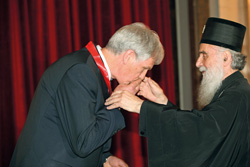 1907. Erection of the first memorial, the Serbian Ossuary, with the remains of warriors fallen in the 1876-1878 and 1885 wars. 1907. Erection of the first memorial, the Serbian Ossuary, with the remains of warriors fallen in the 1876-1878 and 1885 wars.
1927. Completion of the transfer of the remains and monuments from the old Tašmajdan Cemetery to a special alley at the New Cemetery. Due to the historical or cultural significance of people buried there, it was called the Alley of the Greats. Construction of the World War I Jewish Warriors Ossuary.
1931. Making of a new memorial whole, the Ossuary of Serbian Defenders of Belgrade 1914-1918, with a monument of a soldier and crypt with the remains of 3.529 identified and 1.074 unidentified soldiers.
 1935. Construction of the Russian Ossuary. Its crypt keeps the remains of 387 Russian soldiers fallen in the Southern-Slavic lands during World War I. (Members of other allied armies in World War I rest at the New Cemetery, as well as those of war enemies of Serbia, thus different military cemeteries were formed as special memorial wholes: French, Italian, Austro-Hungarian, Bulgarian, German and English military cemeteries.) 1935. Construction of the Russian Ossuary. Its crypt keeps the remains of 387 Russian soldiers fallen in the Southern-Slavic lands during World War I. (Members of other allied armies in World War I rest at the New Cemetery, as well as those of war enemies of Serbia, thus different military cemeteries were formed as special memorial wholes: French, Italian, Austro-Hungarian, Bulgarian, German and English military cemeteries.)
1959. Memorial cemetery of the victims of fascism in Belgrade 1941-45.
1964. Founding of the Alley of Distinguished Citizens.
1965. Memorial cemetery of the victims of the Belgrade bombing in 1941 and 1944.
1971. The Alley of War Heroes from World War II.
2003. The New Cemetery became member of the Association of Culturally Significant Cemeteries in Europe (ASCE).
2010. The New Cemetery was enlisted in the European Cultural Route of the Council of Europe.
The deceased who have a family tomb provided earlier are still being buried at the New Cemetery. The rest is the social-political-cultural history of this city and the countries it was and is the capital of.
ARTISTIC HERITAGE
 The New Cemetery has more than 1.500 sculptural monuments in stone and bronze, works of more than 130 remarkable artists, and is a true ”open museum”. Many authors of artistically valuable monuments haven’t left any traces about themselves. Besides the Church of St. Nicholas, this memorial complex also includes 38 private chapels, works of famous Serbian and Russian architects. The New Cemetery has more than 1.500 sculptural monuments in stone and bronze, works of more than 130 remarkable artists, and is a true ”open museum”. Many authors of artistically valuable monuments haven’t left any traces about themselves. Besides the Church of St. Nicholas, this memorial complex also includes 38 private chapels, works of famous Serbian and Russian architects.
A remarkable monument itself, the New Cemetery was proclaimed a cultural and historical good of extraordinary importance for the Republic of Serbia in 1983.
”The New Cemetery in Belgrade… is also valuable within the world monumental heritage of its kind”, states art historian Jovan Sekulić, longtime director of the Republic Institute for the Protection of Cultural Monuments. ”It is an open book including the greatest names, great people of history, culture and arts.”
A special value of the New Cemetery, a sign differentiating it from other culturally significant European cemeteries, is handmade cast iron fences, mostly created between the two wars. Constantly exposed to atmospheric influences, not treated professionally, this cultural heritage is much endangered and requests urgent radical protection.
DELICATE HUMANISTIC MISSION
 The Belgrade company ”Pogrebne usluge”, practically founded at the New Cemetery and its heritage, applies the highest European standards in this area. The Belgrade company ”Pogrebne usluge”, practically founded at the New Cemetery and its heritage, applies the highest European standards in this area.
– We are aware of the fact that the city has entrusted us with a complex, difficult and delicate, yet very humane mission: to help our fellow citizens in 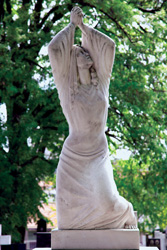 their most difficult moments, when they encounter the loss of their dearest ones. Respecting the piety towards the deceased, deeply respecting the sorrow of our fellow citizens, we make efforts every day to be worthy of our humanistic mission – says Dragan Baltovski, M.A. their most difficult moments, when they encounter the loss of their dearest ones. Respecting the piety towards the deceased, deeply respecting the sorrow of our fellow citizens, we make efforts every day to be worthy of our humanistic mission – says Dragan Baltovski, M.A.
As a recognition for such an approach and work, His Holiness Patriarch of Serbia Irinej recently granted the Ordain of St. Sava to the first man of this company Dragan Baltovski.
The activity of ”Pogrebne usluge”, which also includes the New Cemetery, is officially ”of special social interest”. The company includes ten biggest and oldest cemeteries in Belgrade, with a crematorium and city chapel. It performs more than 10.000 funerals and about two and a half thousand cremations each year. The burials take place every day except Sundays and first days of a public holiday.
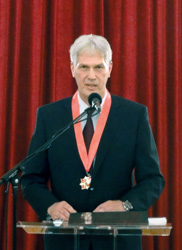 All cemeteries and the administration building are connected in a single information system and the dispatching center works 24 hours a day, every day of the year. Besides funeral services, the company also has the highest quality funeral equipment, wreaths, flowers, tombstones and furniture made of granite, marble, bronze... The employees of this company maintain 350 hectares of green areas, about 100 kilometers of roads, more than 4.000 fountains, numerous chapels, paths in the parcels, fences and other utility objects at cemeteries. All cemeteries and the administration building are connected in a single information system and the dispatching center works 24 hours a day, every day of the year. Besides funeral services, the company also has the highest quality funeral equipment, wreaths, flowers, tombstones and furniture made of granite, marble, bronze... The employees of this company maintain 350 hectares of green areas, about 100 kilometers of roads, more than 4.000 fountains, numerous chapels, paths in the parcels, fences and other utility objects at cemeteries.
The cemeteries are also continuous construction sites. The reconstructions of old tombs and memorials, widening alleys, repairing streets, designing and constructing new concrete graves, constructing memorial walls and installing niches are everyday tasks of the construction employees of ”Pogrebne usluge”.
A HELPING HAND
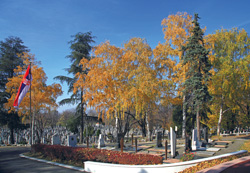 In the moments of sorrow, the thing one mostly needs is understanding. Heavy emotions confront the tormenting reality. Questions demanding fast and practical answers stand before a shocked human. Who to ask for help in such a situation? What to do next to have the deceased seen off and mourned properly and with piety? In the moments of sorrow, the thing one mostly needs is understanding. Heavy emotions confront the tormenting reality. Questions demanding fast and practical answers stand before a shocked human. Who to ask for help in such a situation? What to do next to have the deceased seen off and mourned properly and with piety?
For 125 years now, generations of Belgrade people have known where to find help in such difficult situations. The city utility company for funeral services – whether called ”Vladanovac”, ”New Cemetery”, ”Pogrebni zavod”, or (as called today) ”Pogrebne usluge” – has always been the right address.
***
Monograph
The representative monograph New Cemetery in Belgrade – Open Testimony of History, celebrating the 125 anniversary of its founding published by ”Pogrebne usluge” was successfully presented at the 56th International Book Fair in Belgrade (on October 27) and at the Ceremonial Session for the Jubilee at the Old Palace (November 2). This luxurious and capital publication, which upgraded the previous one from 1999, was expanded and enriched with new documentary material and texts, made according to high publishing standards implied by the new era.
– The monograph about the New Cemetery is our contribution to marking important dates in history and preserving important postulates of the national identity, culture and tradition – says Dragan Baltovski, M.A., author of the foreword.
***
Truly Elite Place
Many great people rest among the deceased Serbs at the New Cemetery. Statesmen Ilija Garašanin, Jovan Ristić, Laza Pačuo, Nikola Pašić, Jovan Avakumović, Jevrem Grujić... Scientists Stojan Novaković, Jovan Cvijić, Jovan Skerlić, Milutin Milanković, Mihailo Valtrović, Vladan Djordjević, Matija Ban... Writers Djura Jakšić, Radoje Domanović, Petar Kočić, Laza Lazarević, Bora Stanković, Simo Matavulj, Sima Milutinović Sarajlija, Svetolik Ranković, Stevan Sremac, Branislav Nušić, Ivo Andrić... Fine artists Djordje Krstić, Stevan Todorović, Nadežda Petrović, Katarina Ivanović, Beta Vukanović, Anastas Jovanović, Paja Jovanović, Djordje Jovanović, Petar Ubavkić, Simeon Roksandić...
***
List of Great People
... Music artists Stevan Mokranjac, Kornelije Stanković, Stanislav Binički, Josif Marinković... Drama artists Pera Dobrinović, Milka Grgurova, Vela Nigrinova, Nikola Gošić, Ilija Stanojević, Dobrica Milutinović... Architects Nikola Dobrović, Jovan Ilkić, Dimitrije Leko, Andra Stevanović... Dukes Uzun Mirko Apostolović, Ilija Čarapić, Petar Bojović, Radomir Putnik, Živojin Mišić...
At the end of the previous and beginning of this century Miloš Crnjanski, Milorad Pavić, Petar Lubarda, Danilo Kiš, Pavle Savić, Zoran Radmilović, Olja Ivanjicki, Momo Kapor, Petar Kralj... arrived to the New Cemetery.
***
In the Spirit of Heritage
The Cemetery got its present authentic appearance after the erection of the fence around the French Military Cemetery (1931/32), Funeral Chapel (1935) and Chapel for the funerals of Ashkenazi Jews (1937). These objects make a unique representative whole, giving the New Cemetery the spirit of medieval architecture and Byzantine heritage.
***
Tomb of the Patriarch
”Pogrebne usluge” is also engaged outside of the city cemeteries. Within its activities, it prepared a tomb for the deceased Patriarch Pavle in the Monastery of the Ascension of Virgin Mary in Rakovica, designed and constructed the tombstone and reconstructed the whole plateau where, besides Patriarch Pavle, also rests Patriarch Dimitrije.
|
